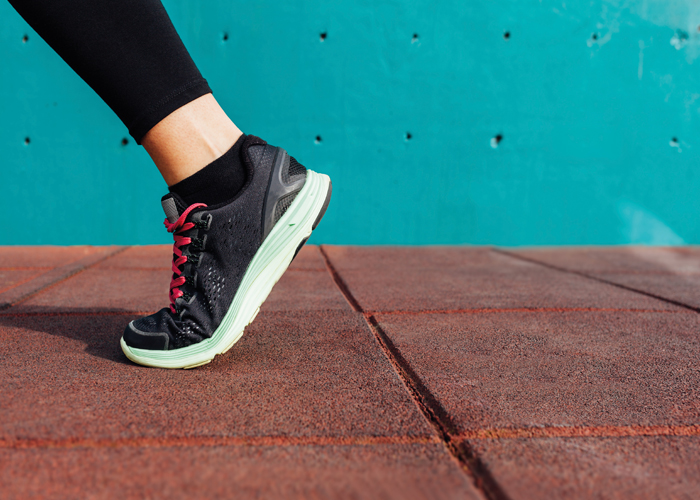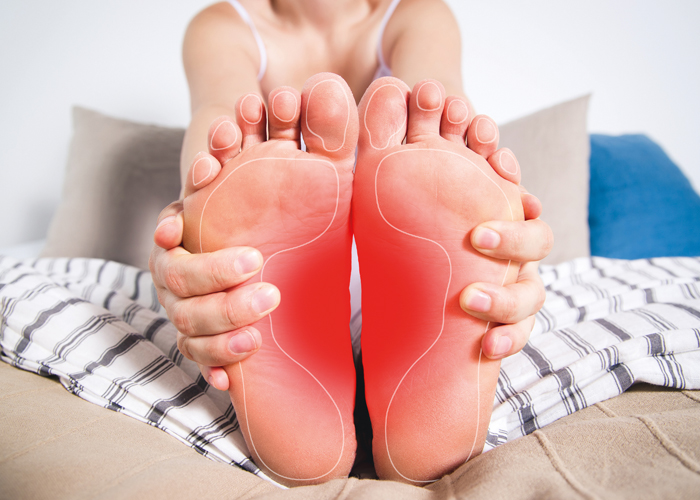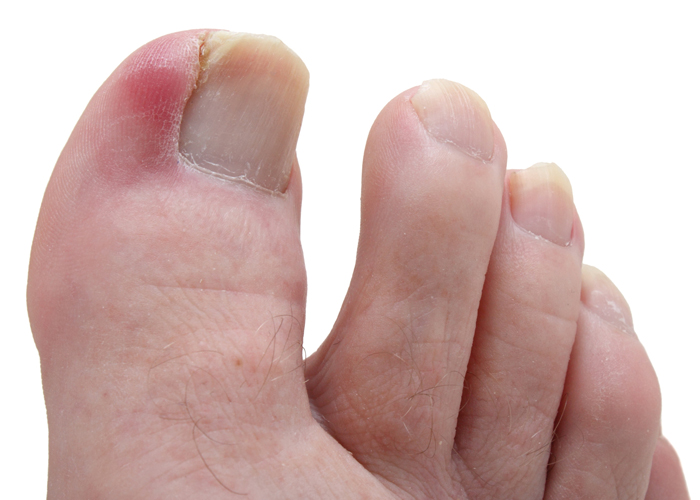Step by step
In OTC
Follow this topic
Bookmark
Record learning outcomes
Summer is here and as lockdown gradually lifts, people will be out and about more often. So, it’s the ideal time for pharmacy teams to remind customers to take steps to look after their feet and advise them on a range of common conditions
Feet have a lot of pressure on them – literally. They hold up the entire weight of the body every day. Despite this, footcare is often neglected and foot conditions are common, with around 90 per cent of people in the UK experiencing some sort of problem with their feet during their lives.

Customers may be embarrassed about how their feet look, which can mean they don’t seek advice in the pharmacy when symptoms first appear. However, foot conditions can get worse if left untreated, leading to uncomfortable and often painful results, especially if they start to affect the way someone walks, or if the person has diabetes.
As the feet are the foundations for the rest of the body, foot problems that affect walking can lead to issues with the knees, hips and even back problems, demonstrating just how important it is to treat foot conditions as soon as they occur.
From athlete’s foot to oedema, there are a whole host of issues that affect feet and lower legs, some of which may become more prevalent when communal gyms and swimming pools start to reopen. Fortunately, many minor foot and leg conditions can be treated with over-the-counter (OTC) products and self care advice available from the pharmacy.
Prevention is key
Customers with persistent foot problems may benefit from visiting a podiatrist. “In the same way that they would go to the dentist about their teeth or optometrist for their eyes, podiatrists are here for their feet,” advises Emma McConnachie, vice president of the College of Podiatry. “Recurrent infections, heel pain of longer than two weeks’ duration, verrucae and corns are conditions that commonly result in a patient being advised by pharmacy staff to attend the podiatrist.”
However, there are simple steps that can be taken to prevent certain foot conditions from occurring in the first place. Emma says pharmacy teams can advise customers on the following general self care tips for keeping their feet healthy:
- Wash and dry the feet every day, especially between the toes
- Make sure shoes fit properly and are appropriate for any activities
- For toenails, customers should choose filing over cutting, as this is one of the best ways to safely manage them. If they choose to cut them, they should “ditch the scissors and use clippers or nippers to cut them straight across”, Emma says
- Regularly apply moisturiser to the feet, avoiding the area between the toes. “Any cream will do, but special foot creams that contain urea are excellent for a boost or for regular management of drier skin,” Emma adds.
Prevention techniques for individual foot conditions can be found below.
Diabetes and footcare
Taking care of their feet is particularly important for people with diabetes. Recent figures released by Public Health England reveal an increasing rate of lower limb amputations, with 27,465 lower limb amputations related to diabetes in England from 2015 to 2018, marking an increase of 18.3 per cent from 2011 to 2014. This worrying statistic demonstrates the importance of footcare in people living with diabetes, as they are at an increased risk of foot conditions.
People with diabetes often have high blood glucose levels and experiencing this for sustained periods can damage blood vessels, including those that supply blood to the nerves. This most commonly affects the feet and can cause reduced feeling in this area, which is referred to as neuropathy. “Those with poorer glycaemic control or who have been unaware of their condition for a prolonged time will more commonly develop issues,” explains Emma.
Reduced feeling in the feet can cause problems, as the individual may not notice minor injuries that occur. If left untreated, minor injuries can become infected or develop into ulcers. According to the charity Diabetes UK, unhealed ulcers and foot infections are the leading cause of diabetes-related amputations.
Pharmacy teams should encourage people with diabetes to check their feet every day and remind them that they should not attempt to treat foot problems themselves. “If they have any concerns about changes in their feet then they should contact their podiatrist for advice as soon as possible,” advises Emma.
People with diabetes should not attempt to treat foot problems themselves
Focus on feet
Not just for athletes
Athlete’s foot is a contagious condition that is often picked up from communal areas such as swimming pool and changing room floors. It is caused by a fungus called tinea pedis, which thrives in warm, damp environments, such as the area between the toes. The infected skin can become white and itchy and, in more severe cases, it can crack and bleed.
To help relieve symptoms, antifungal treatments are available over the counter (OTC) and there are two main types:
- Fungistatics (e.g. clotrimazole) slow down the growth rate of the fungus. Most fungistatics should be applied two to three times per day. After the infection is cleared, treatment should continue for two weeks to ensure it does not return
- Fungicides (e.g. terbinafine) kill the fungus and are usually applied once or twice a day for a week.
There are also certain measures customers can take to help prevent athlete’s foot from reoccurring, such as:
- Drying feet thoroughly after washing, particularly between the toes
- Wearing clean cotton socks each day
- Avoiding sharing towels, socks or shoes with others
- Wearing flip-flops in communal areas.
Problems with pressure
Plantar fasciitis is characterised by pain on the bottom of the foot, around the arch and heel. “It is a very common cause of pain and it tends to be about an inch forward from the base of the heel,” explains Dr Sarah Jarvis, GP and clinical director of the online health information resource Patient. It is caused by inflammation of the plantar fascia, which is a tough band of connective tissue that runs along the base of the foot and supports the bones and the arch of the foot.
Customers may experience plantar fasciitis from standing, walking or running more than usual, especially if they are wearing shoes with poor cushioning and arch support. Dr Jarvis notes that the condition can also be caused by running on a different surface than usual, such as switching from running on grass or a track to running on a road or pavement.
Pharmacy teams can recommend cushioned heel pads or insoles for customers to wear inside their shoes. Other self care tips that customers could try include applying an ice pack to the affected area for 20 minutes every two to three hours and taking paracetamol. There are also exercises that can be recommended to ease foot pain, which can be found on various websites, such as Patient.info and NHS Inform.

A communal issue
Verrucas, also known as plantar warts, usually appear on the ball of the foot, the underside of the big toe or the heel, either alone or in clusters. They appear as hard, flat and discreet lesions and small black spots may be visible, which are caused by bleeding in small blood vessels. Verrucas are caused by the human papilloma virus and are often picked up from the floors of communal areas. They are generally not serious, but they may cause discomfort when walking.
Creams and plasters can be purchased OTC, which often contain salicylic acid to destroy infected skin. These products can take up to three months to work, so it’s important for pharmacy teams to manage customers’ expectations. Freeze treatments (cryotherapy) are also available from pharmacy and provide more rapid relief, with most requiring only one application.

The hard stuff
Corns and calluses are thickened, hard areas of skin that can cause pain when pressure is applied, such as when walking. Corns are small lumps, whereas calluses span a larger area. They are caused by repeated pressure on a specific area, usually from shoes that are too tight or rub the feet, or from not wearing socks with shoes.
Pharmacy teams can recommend soft insoles or heel pads to be inserted into shoes to ease pressure. Pumice stones or products containing salicylic acid can help to remove hard skin and the feet can be moisturised to keep the skin soft. Customers should be advised to wear shoes that fit well and don’t rub the feet.
Cracking up
When walking, the skin on the heel stretches in response to pressure. Dry skin is less flexible and this pressure can cause skin to become dry, scaly and cracked. In severe cases, the cracks may bleed, or become inflamed or infected. Cracked heels are particularly prevalent in older people, as the skin loses elasticity and becomes dryer with age.
A foot file, pumice stone or exfoliating product can be used to remove the affected hard skin, and pharmacy teams can recommend regularly moisturising the area to keep skin hydrated. If the cracked skin is weeping, the customer should be referred to the pharmacist.
Verrucas are caused by the human papilloma virus and are often picked up from the floors of communal areas
Nailing it
Understanding infection
Fungal nail infections – also known as tinea unguium or onychomycoses – are very common and account for 50 per cent of all nail diseases in adults. They can be caused by the same fungus that is responsible for athlete’s foot, which can spread from the skin to the nails.
An infected nail tends to discolour and thicken, usually starting at the edge of the nail and spreading towards the middle. If left untreated, the nail can become brittle and start to crumble, which can cause discomfort and swelling.
Topical treatments for mild fungal nail infections are available OTC. Pharmacy teams can recommend antifungal solutions, such as those containing amorolfine, or solutions that make the nail acidic, as this type of environment inhibits fungal growth. Oral antifungal tablets are available on prescription for more severe or recurrent infections.
Fungal nail infections are very common and account for 50 per cent of all nail diseases in adults

A painful problem
Another common condition that affects the nails is ingrown toenail. This is when the nail pushes into the skin of the toe, which can cause the toe to swell up and become painful. It most often affects the big toe.
One of the most common causes of ingrown toenail is cutting the nail too short or into the wrong shape. Other causes include a toe injury and badly fitting footwear, which can press toenails into the surrounding skin.
Pharmacy teams can advise customers not to cut the toenail so that it grows out and to wear well-fitting, comfortable shoes. They can also suggest soaking the foot in warm water three to four times a day for a few days in order to soften the skin around the nail.
Pharmacy teams should look out for customers experiencing a fever or if there is pus around the toe, as these are signs of an infection. Customers with these symptoms should be referred to the pharmacist.
Let's talk legs
Circulation concerns
Varicose veins are enlarged veins that commonly develop on the legs and feet. They are sometimes twisted or lumpy and may be blue or purple in colour. The area can ache or feel heavy and uncomfortable and muscle cramps can occur, particularly at night.
In a healthy vein, there are valves that control the blood flow, ensuring that it flows towards the heart. If these valves become weakened and stop functioning properly, blood can collect in the vein, causing the vein to become varicose. Certain people are more likely to develop varicose veins, such as older individuals, women and people that stand for long periods as part of their job. They are often worse in warm weather.
If varicose veins are causing discomfort, customers should be referred to the pharmacist. Pharmacy teams can recommend that customers take regular exercise, elevate the legs to ease symptoms and avoid standing or sitting for long periods.

Oedema usually goes away by itself, but pharmacy teams can advise customers to take some gentle exercise
Spot the swelling
Swelling of the lower legs is known as oedema and this often affects the feet and ankles too. It is usually due to a build-up of fluid and common causes include pregnancy, being overweight and sitting in the same position for too long.
Oedema usually goes away by itself, but pharmacy teams can advise customers to take some gentle exercise or lie down and raise the swollen area on pillows, which may help ease the swelling.
It’s important for pharmacy teams to check that the swelling is not caused by something more serious, such as heart failure, by asking appropriate questions. There are certain red flag symptoms to look out for. “Shortness of breath when you lie down, shortness of breath on exercise, and waking up at night short of breath are all red flags for oedema,” advises Dr Sarah Jarvis, GP and clinical director of the online health information resource Patient. “Oedema on one side is also much more likely to be a red flag, as you could have a clot on the leg, which could travel to the lung, or you could have infection.” If a customer presents with one of these red flag symptoms, pharmacy teams should refer them to the pharmacist, who may recommend they see a GP.

